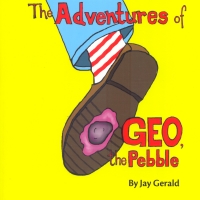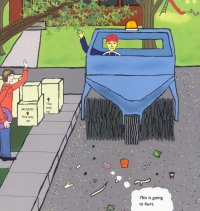| ________________
CM . . . . Volume XIX Number 11 . . . . November 16, 2012
excerpt:
This picture book follows the geological life span of a rock. In prehistoric times, Geo provides a resting spot for lizards and squirrels. In an ancient city, he is made part of a stone wall. As years pass, he becomes part of a ship’s ballast and sinks with the vessel during a storm and later is discovered by a scuba diver. Moving to the present day, Geo is placed on display in a dish on the fireplace mantle of a suburban home. He gets unceremoniously thrown out and is swept up by the neighbourhood street cleaner, bounces out of a dump truck, and lands in a front yard. After being stuck to chewing gum on the bottom of a shoe, Geo finally ends his journey in a child’s pocket “for safekeeping”.
At the end of the book, the narration abruptly shifts to second person:“you kicked Geo down the sidewalk, you played street hockey on top of Geo, and your grandma drove over him with the wagon.” This change in style is somewhat jarring. The simple line drawings have a childlike appearance. The human figures appear out of proportion, with either small heads and thick bodies, or large heads and tiny hands. In some cases, Geo looks larger in the illustrations than as described in the text. Geo seems to grow bigger as you turn the first two pages when he is meant to be smaller. The idea of tracing an object through time and discovering the extraordinary in the ordinary has lots of appeal. However, the inconsistencies in the text and illustrations prevent this book from being a first-choice purchase. Not Recommended. Linda Ludke is a librarian in London, ON.
To comment
on this title or this review, send mail to cm@umanitoba.ca.
Copyright © the Manitoba Library Association. Reproduction for personal
use is permitted only if this copyright notice is maintained. Any
other reproduction is prohibited without permission.
NEXT REVIEW |
TABLE OF CONTENTS FOR THIS ISSUE
- November 16, 2012.
AUTHORS |
TITLES |
MEDIA REVIEWS |
PROFILES |
BACK ISSUES |
SEARCH |
CMARCHIVE |
HOME |

 The writing style has a conversational tone: “The funny thing about rocks is they get smaller as they get older. Not like you.” The text includes many comparisons to help readers visualize Geo’s decreasing size. The rock is said to resemble “a watermelon”, “a football”, “two pieces of toast put side by side”, “your shoe”, “an apple” and “a plum”. Readers don’t get such a vivid sense of the different time periods that Geo lives through. When surveying the ancient world, Geo sees “People coming and going on the road, herding sheep or waving their arms and telling stories”. More details about the various places and time periods would have enhanced the story.
The writing style has a conversational tone: “The funny thing about rocks is they get smaller as they get older. Not like you.” The text includes many comparisons to help readers visualize Geo’s decreasing size. The rock is said to resemble “a watermelon”, “a football”, “two pieces of toast put side by side”, “your shoe”, “an apple” and “a plum”. Readers don’t get such a vivid sense of the different time periods that Geo lives through. When surveying the ancient world, Geo sees “People coming and going on the road, herding sheep or waving their arms and telling stories”. More details about the various places and time periods would have enhanced the story.